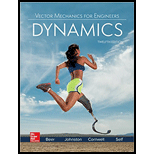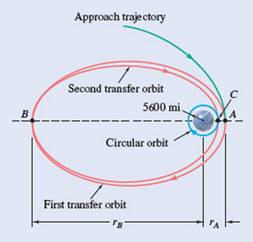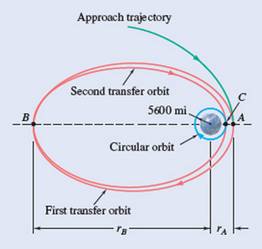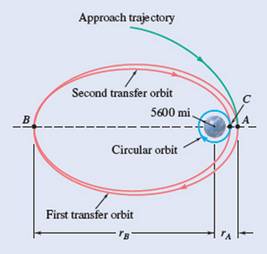
Concept explainers
A space probe is to be placed in a circular orbit of 5600-mi radius about the planet Venus in a specified plane. As the probe reaches A, the point of its original trajectory closest to Venus, it is inserted in a first elliptic transfer orbit by reducing its speed by

(a)
The velocity of the probe should be reduced at point
Answer to Problem 12.105P
The velocity reduction at point
Explanation of Solution
Given information:

Initial velocity corresponding to a parabolic orbit,
Angular momentum of a unit mass,
If the trajectory is an elliptical orbit,
Calculation:
Initial velocity corresponding to a parabolic orbit,
Since,
Then consider the first transfer elliptical orbit,
Applying angular momentum equation,
Therefore the velocity reduction at point
(b)
The velocity of the probe should be reduced at
Answer to Problem 12.105P
The velocity reduction at point
Explanation of Solution
Given information:

Angular momentum of a unit mass,
If the trajectory is an elliptical orbit,
Calculation:
Consider the first transfer elliptical orbit,
Then consider the second transfer elliptical orbit,
Since,
Applying angular momentum equation,
Therefore, the velocity reduction at point
(b)
The velocity of the probe should be reduced at
Answer to Problem 12.105P
The velocity reduction at point
Explanation of Solution
Given information:

Angular momentum of a unit mass,
Initial velocity corresponding to a circular orbit,
Calculation:
Consider the second transfer elliptical orbit,
Then consider the circular orbit at
Since,
Therefore the velocity reduction at point
Want to see more full solutions like this?
Chapter 12 Solutions
VECTOR MECH...,DYNAMICS(LOOSE)-W/ACCESS
- At engine burnout on a mission, a shuttle had reached point A at an altitude of 40 mi above the surface of the earth and had a horizontal velocity v0. Knowing that its first orbit was elliptic and that the shuttle was transferred to a circular orbit as it passed through point B at an altitude of 170 mi, determine (a) the time needed for the shuttle to travel from A to B on its original elliptic orbit, (b) the periodic time of the shuttle on its final circular orbit.arrow_forwardWhile describing a circular orbit, 185 mi above the surface of the earth, a space shuttle ejects at point A an inertial upper stage (IUS) carrying a communications satellite to be placed in a geosynchronous orbit (see Prob. 13.87) at an altitude of 22,230 mi above the surface of the earth. Determine (a) the velocity of the IUS relative to the shuttle after its engine has been fired at A,( b) the increase in velocity required at B to place the satellite in its final orbit.Reference to Problem 13.87:arrow_forwardA spacecraft is describing an elliptic orbit of minimum altitude hA = 2400 km and maximum altitude hB = 9600 km above the surface of the earth. Determine the speed of the spacecraft at A.arrow_forward
- A spacecraft traveling along a parabolic path toward the planet Jupiter is expected to reach point vA of magnitude 26.9 km/s. Its engines will then be fired to slow it down, placing it into an elliptic orbit which will bring it to within 100 × 103 km of Jupiter. Determine the decrease in speed ? v at point A which will place the spacecraft into the required orbit. The mass of Jupiter is 319 times the mass of the earth.arrow_forwardA satellite describes an elliptic orbit about a planet of mass M . The minimum and maximum values of the distance r from the satellite to the center of the planet are, respectively, r0 and r1. Use the principles of conservation of energy and conservation of angular momentum to derive the relationwhere h is the angular momentum per unit mass of the satellite and G is the constant of gravitation.arrow_forwardA communications satellite is in a circular orbit above the earth such that it always remains directly over a point on the earth’s surface. As a result, the period of the satellite must equal the rotation of the earth,which is approximately 24 hours. Determine the satellite’s altitude h above the earth’s surface and its orbital speed.arrow_forward
- A 30,000 kg spacecraft is approaching the moon on a hyperbolic trajectory at an altitude of 1,000 km and a speed of 10 km/s. The spacecraft must be lowered into a circular parking orbit with altitude of 100 km. After three orbits at 100 km for system checks, the lander is deployed and conducts a maneuver to land on the surface of the moon at a position 180° from the impulse point. Determine the total required Δ? to conduct the transfer into the circular orbit, in km/s Determine the required propellant mass for that maneuver, in kg Determine the required Δ? to transfer to the landing trajectory Determine the total time required from the start of the initial transfer orbit until landing, in harrow_forwardA satellite is in circular orbit around Earth at an altitude of three Earth radii above the surface. If the satellite uses onboard retro rockets to cut its speed to one half, at what distance from Earth can it establish a new stable circular orbit? Hint: vorbit =arrow_forwardA satellite of mass m is put into an elliptical orbit around the earth. At point A, its distance from the earth is h1=500km and it has a velocity V1=30,000km/h. Determine the velocity V2 of the satellite as it reaches point B, a distance h2=1200km from the earth?arrow_forward
- Communication satellites are placed in a geosynchronous orbit, i.e., in a circular orbit such that they complete one full revolution about the earth in one sidereal day (23.934 h), and thus appear stationary with respect to the ground. Determine (a) the altitude of these satellites above the surface of the earth, (b) the velocity with which they describe their orbit. Give the answers in both SI and U.S. customary units.arrow_forwardIt was observed that during the Galileo spacecraft’s first flyby of the earth, its minimum altitude was 600 mi above the surface of the earth. Assuming that the trajectory of the spacecraft was parabolic, determine the maximum velocity of Galileo during its first flyby of the earth.arrow_forwardHow much energy per pound should be imparted to a satellite in order to place it in a circular orbit at an altitude of (a) 400 mi, (b) 4000 mi?arrow_forward
 Elements Of ElectromagneticsMechanical EngineeringISBN:9780190698614Author:Sadiku, Matthew N. O.Publisher:Oxford University Press
Elements Of ElectromagneticsMechanical EngineeringISBN:9780190698614Author:Sadiku, Matthew N. O.Publisher:Oxford University Press Mechanics of Materials (10th Edition)Mechanical EngineeringISBN:9780134319650Author:Russell C. HibbelerPublisher:PEARSON
Mechanics of Materials (10th Edition)Mechanical EngineeringISBN:9780134319650Author:Russell C. HibbelerPublisher:PEARSON Thermodynamics: An Engineering ApproachMechanical EngineeringISBN:9781259822674Author:Yunus A. Cengel Dr., Michael A. BolesPublisher:McGraw-Hill Education
Thermodynamics: An Engineering ApproachMechanical EngineeringISBN:9781259822674Author:Yunus A. Cengel Dr., Michael A. BolesPublisher:McGraw-Hill Education Control Systems EngineeringMechanical EngineeringISBN:9781118170519Author:Norman S. NisePublisher:WILEY
Control Systems EngineeringMechanical EngineeringISBN:9781118170519Author:Norman S. NisePublisher:WILEY Mechanics of Materials (MindTap Course List)Mechanical EngineeringISBN:9781337093347Author:Barry J. Goodno, James M. GerePublisher:Cengage Learning
Mechanics of Materials (MindTap Course List)Mechanical EngineeringISBN:9781337093347Author:Barry J. Goodno, James M. GerePublisher:Cengage Learning Engineering Mechanics: StaticsMechanical EngineeringISBN:9781118807330Author:James L. Meriam, L. G. Kraige, J. N. BoltonPublisher:WILEY
Engineering Mechanics: StaticsMechanical EngineeringISBN:9781118807330Author:James L. Meriam, L. G. Kraige, J. N. BoltonPublisher:WILEY





